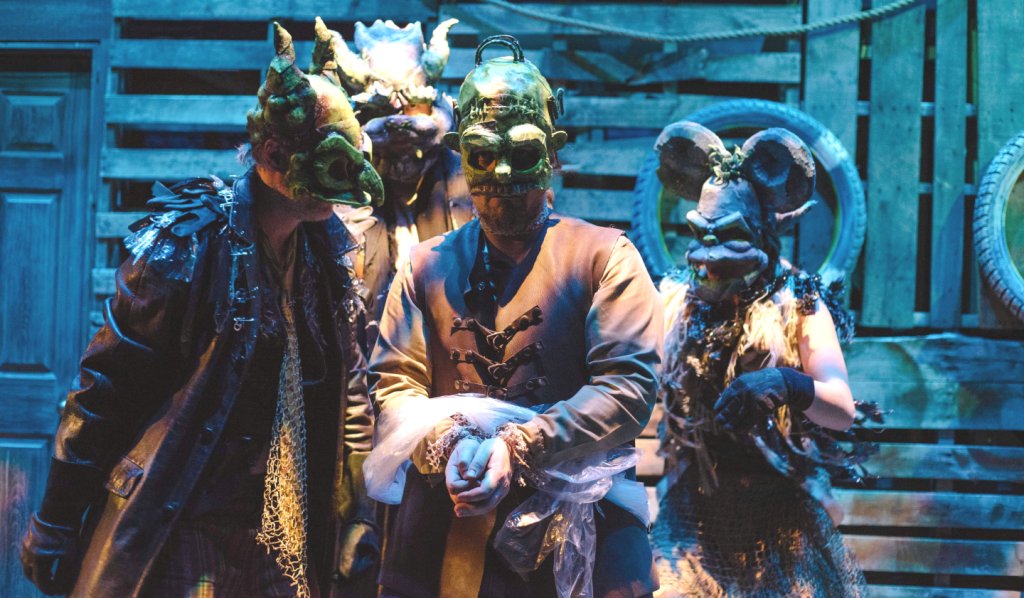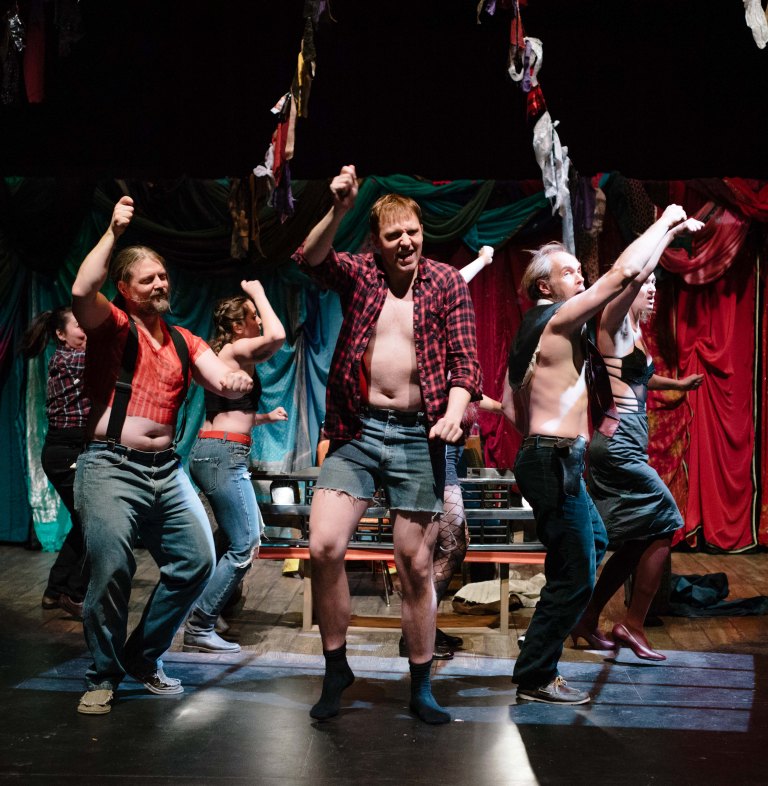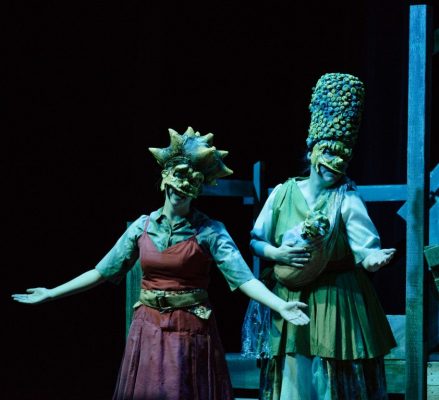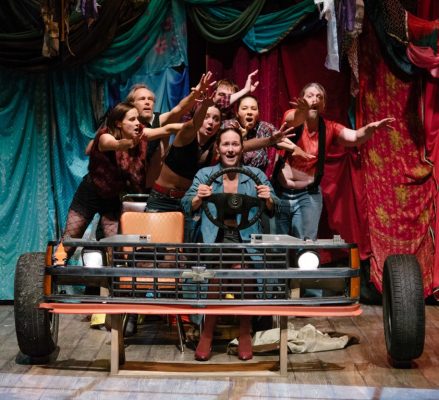Bold new play turns The Simpsons on its head to create futuristic religion
Posted on November 29, 2019 By Colin MacLean Entertainment, Front Slider, Theatre
 Mr. Burns, a Post-Electric Play is a dark comedy written by Anne Washburn. It’s based on Cape Feare on The Simpsons (Season 5 Episode 2), which is a take-off of the 1961 Robert Mitchum thriller. In this one, Sideshow Bob tries to kill Bart on a houseboat.
Mr. Burns, a Post-Electric Play is a dark comedy written by Anne Washburn. It’s based on Cape Feare on The Simpsons (Season 5 Episode 2), which is a take-off of the 1961 Robert Mitchum thriller. In this one, Sideshow Bob tries to kill Bart on a houseboat.
Mr. Burns is not just a satire of a satire but an ingenious, intellectually challenging original futuristic epic. The new production is from You Are Here Theatre and Blarney Productions and runs in the Westbury Theatre of the ATB Financial Arts Barns through Dec. 7.
 The work is divided into three parts – and each is a different play with the same cast in a different setting. Act I happens shortly after a major catastrophe. Nuclear plants are melting down and the power grid has collapsed. A tattered group gathers around a flaming campfire in a desperate effort to remember the plot and dialogue of that episode of The Simpsons. All this is happening in a very dark place filled with unknown dangers. Survival itself is an iffy proposition.
The work is divided into three parts – and each is a different play with the same cast in a different setting. Act I happens shortly after a major catastrophe. Nuclear plants are melting down and the power grid has collapsed. A tattered group gathers around a flaming campfire in a desperate effort to remember the plot and dialogue of that episode of The Simpsons. All this is happening in a very dark place filled with unknown dangers. Survival itself is an iffy proposition.
(I must admit to a sad omission in my cultural life – I, and possibly a lonely Japanese soldier lost in the jungles of Borneo since WW II, may be the only people on earth who have never seen The Simpsons. If you have missed this particular one you might – as I did – go to You Tube and summon up the Cape Feare episode. It will really help in understanding the first act, which goes into forensic detail.)
The next act takes place seven years later and the ragtag group has banded into a theatre troupe. They are preparing a dramatic piece based on the episode (complete with commercials). The act centres around the group attempting their own version of the original in desperate competition with others who are trying the same thing. Sort of like religious groups, each of whom claims to have the real word of God. The act ends as the troupe presents a song-and-dance routine based on what are probably half-remembered touchstones of mid-20th Century culture – Gangham Style, Stayin’ Alive, Thriller, The Macarena and others.
 The third act turns out to be a musical (music by Michael Friedman; Mhairi Berg is also credited in the program as composer, with lyrics by Anne Washburn). We have now leapt 75 years ahead and are watching a fully-staged production of the episode – which has become a combination of morality play, Broadway style musical and classic Greek theatre. There are echoes of the original TV show here, and bits and pieces of the first two acts, but the transformation is complete and the result could only come from the sensibilities of the emerging New World. Apparently Cape Feare has taken on a sacred textual import; it is now something of a myth and an unlikely cultural pillar in the rebuilding of society.
The third act turns out to be a musical (music by Michael Friedman; Mhairi Berg is also credited in the program as composer, with lyrics by Anne Washburn). We have now leapt 75 years ahead and are watching a fully-staged production of the episode – which has become a combination of morality play, Broadway style musical and classic Greek theatre. There are echoes of the original TV show here, and bits and pieces of the first two acts, but the transformation is complete and the result could only come from the sensibilities of the emerging New World. Apparently Cape Feare has taken on a sacred textual import; it is now something of a myth and an unlikely cultural pillar in the rebuilding of society.
The final set is an ambitious two-level wooden stage. All three stages are impressive and, obviously the result of a lot of work by set and costume designer Brianna Kolybaba. In Act III performers all wear some remarkable stylized Greek theatre masks wrought by Megan Koshka. Lana Hughes’ sound design is amazingly crisp and serves well to establish the atmosphere. There was one thunderclap that probably rattled the dishes in Hinton.
Washburn has certainly polarized her audiences. Reviews have ranged from Ben Brantley’s “Downright brilliant” in the New York Times to Simpson’s writer Mike Reiss’, “The show fails because the play is what The Simpsons itself never was, grim, pretentious and dull.” One critic noted, “Seriously, I had no idea what was going on.” Another found it “…ingenious, scrappy and filled with pop culture cleverness.”
 Reiss is just simply flat out wrong. Mr. Burns is not an episode of The Simpsons but a thoughtful contemplation on how symbols change meaning over time. The playwright’s ambitious concept here is to explore our desperate need for storytelling (particularly theatre) as a basic wellspring of civilization.
Reiss is just simply flat out wrong. Mr. Burns is not an episode of The Simpsons but a thoughtful contemplation on how symbols change meaning over time. The playwright’s ambitious concept here is to explore our desperate need for storytelling (particularly theatre) as a basic wellspring of civilization.
You certainly can’t take exception to the talent in this local production – which succeeds in brilliantly illuminating the playwright’s daring concept. The large cast (Nadien Chu, Murray Farnell, Kristi Hansen, Patrick Howarth, Paula Humby, Madelaine Knight, Jenny McKillop, Elena Porter, Jake Tkaczyk, Rebecca Sadowski) are all well-know and highly skilled local performers adept at realizing their characters through sharply observed, subtle traits. They seamlessly morph from their characters into the comic personas of The Simpsons while recreating the voices of some of the best-known unseen TV voice actors working today. The timing, connection and chemistry between them, under the perceptive and creative direction of Andrew Ritchie, is distinctive and insightful. The complexity of the production in its various times, with its sets, props, costumes and great leaps in cultural evolution, places great demands on the company. There are Mexican stand-offs with guns drawn extending to song-and-dance routines. There’s a bit of Gilbert and Sullivan and the hilarious megamix of Top 40 hits. The original television episode is still vaguely visible through all this but is filtered through the sensibilities of a future society.
Bleak, bizarre, original and devilishly funny.
Photos by BB Collective













